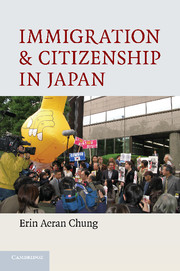Book contents
- Frontmatter
- Contents
- Tables and Figures
- Conventions and Abbreviations
- Acknowledgments
- Immigration and Citizenship in Japan
- Introduction: The Contradictions of Japan's Immigration and Citizenship Politics
- 1 Is Japan an Outlier? Cross-National Patterns of Immigrant Incorporation and Noncitizen Political Engagement
- 2 Constructing Citizenship and Noncitizenship in Postwar Japan
- 3 Negotiating Korean Identity in Japan
- 4 Citizenship as Political Strategy
- 5 Destination Japan: Global Shifts, Local Transformations
- Conclusion
- References
- Index
2 - Constructing Citizenship and Noncitizenship in Postwar Japan
Published online by Cambridge University Press: 03 May 2010
- Frontmatter
- Contents
- Tables and Figures
- Conventions and Abbreviations
- Acknowledgments
- Immigration and Citizenship in Japan
- Introduction: The Contradictions of Japan's Immigration and Citizenship Politics
- 1 Is Japan an Outlier? Cross-National Patterns of Immigrant Incorporation and Noncitizen Political Engagement
- 2 Constructing Citizenship and Noncitizenship in Postwar Japan
- 3 Negotiating Korean Identity in Japan
- 4 Citizenship as Political Strategy
- 5 Destination Japan: Global Shifts, Local Transformations
- Conclusion
- References
- Index
Summary
According to Rogers Brubaker (1992), citizenship policies in the modern world have demonstrated remarkable continuity because they are based on the deeply rooted national traditions of each nation-state. His comparative historical study traces modern German citizenship policies, which were based predominantly on the principle of jus sanguinis until recently, to the ethnocultural understandings of nationhood that preceded the development of the German nation-state. Likewise, he argues that liberal citizenship policies in France have their origins in the assimilationist understandings of nationhood that date back to the rationalist, cosmopolitan tradition of the eighteenth century.
If we were to apply Brubaker's “national traditions” model to the Japanese case, we might surmise that deeply rooted understandings of racial purity in Japanese history inevitably gave rise to descent-based citizenship policies. To be sure, the idea of a “unique” Japanese identity has been a powerful mobilizational tool since the Meiji Restoration of 1868. As John Dower's (1986: 222) powerful study of racial images used during the Pacific War demonstrates, the emperor symbol and the idea of “one blood and one mind” under the emperor became the basis for an ideology that dramatized the “unique character of the nation” and the “racial homogeneity of the people” in order to bring about national unity. In a similar vein, Peter Duus (1995: 415) notes that, although a number of Meiji intellectuals acknowledged the heterogeneous character of the population in ancient times, they argued that these various ethnic groups were “blended” (dōka) and “fused” (yūgō) into the superior Yamato race.
- Type
- Chapter
- Information
- Immigration and Citizenship in Japan , pp. 60 - 81Publisher: Cambridge University PressPrint publication year: 2010



